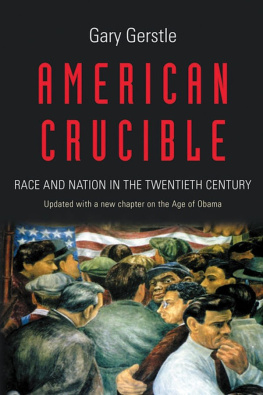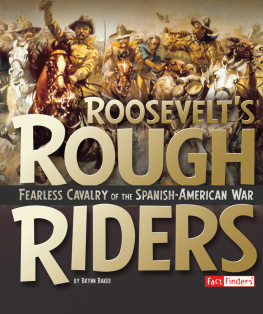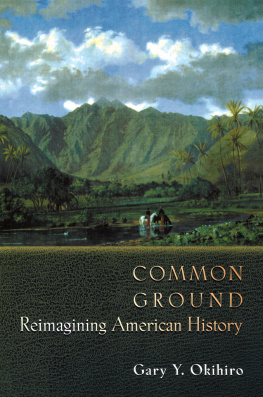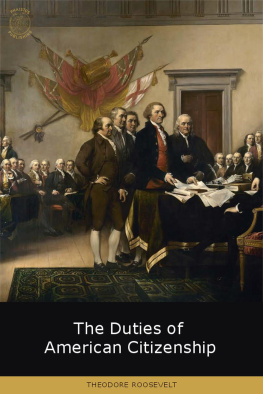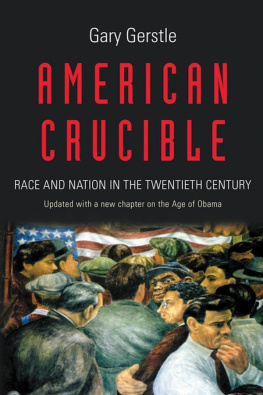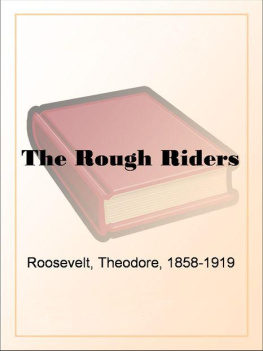AMERICAN CRUCIBLE

GARY GERSTLE
AMERICAN CRUCIBLE

RACE AND NATION IN THE TWENTIETH CENTURY
PRINCETON UNIVERSITY PRESS PRINCETON AND OXFORD
COPYRIGHT 2001 BY PRINCETON UNIVERSITY PRESS
NEW CHAPTER 10 COPYRIGHT 2017 BY PRINCETON UNIVERSITY PRESS
PUBLISHED BY PRINCETON UNIVERSITY PRESS, 41 WILLIAM STREET,
PRINCETON, NEW JERSEY 08540
IN THE UNITED KINGDOM: PRINCETON UNIVERSITY PRESS, 6 OXFORD PLACE, WOODSTOCK, OXFORDSHIRE OX20 1TR
ALL RIGHTS RESERVED
SECOND PRINTING, AND FIRST PAPERBACK PRINTING, 2002
NEW PAPERBACK PRINTING, 2017
PAPERBACK ISBN: 978-0-691-17327-6
THE LIBRARY OF CONGRESS CONTROL NUMBER: 2016960375
BRITISH LIBRARY CATALOGING-IN-PUBLICATION DATA IS AVAILABLE
THIS BOOK HAS BEEN COMPOSED IN SABON
TEXT DESIGNED BY CARMINA ALVAREZ
PRINTED ON ACID-FREE PAPER.
PRESS.PRINCETON.EDU
PRINTED IN THE UNITED STATES OF AMERICA
10 9 8 7 6 5 4 3 2 1
FOR DANNY AND SAM
Contents

Figures

Preface and Acknowledgments for New Edition

M y deepest thanks to the many readers of American Crucible, who have given the book a long and productive life, and whose continuing interest in it has made possible this new edition. My profound thanks to my Princeton University Press editor, Brigitta van Rheinberg, who has been a great supporter of this book since sometime before the turn of the last millennium, and who has contributed in so many ways, large and small, to its success.
I have decided to let the original American Crucible stand as written, with one more exception: what appears as the Epilogue in the original edition has been re-labeled Chapter Nine. A book can always be improved upon, of course. And so much good work has appeared these last fifteen years on race and nationhood in America. But to revise also risks losing the clarity of a books argument and exposition. Better to let a book well known for its interpretation retain its form, and to encourage readers to compare and contrast it with approaches that other writers have pursued.
What this edition does offer is a new last chapter, The Age of Obama, 20002016 that extends the story of American Crucible from the election of George W. Bush in 2000 through the end of the Obama presidency in 2016. The chapters first part examines how Obama, given a lift by both Bill Clinton and Bush, reenergized and refurbished the civic nationalist tradition after its postcivil rights movement demise. The magnitude of Obamas work in reviving this tradition, and in engendering hope in America once again, can be hard to grasp in this 2016 moment of political pessimism. But Obamas contribution to this revival, specifically in making an age-old dream of civic nationalism integral to the process of Americas becoming a majority minority nation, will one day be recognized for the major intervention it has been.
The chapters second half makes clear why Obamas civic nationalist dream seems so distant now: at every turn of his presidency, his opponents challenged not only his policies but his legitimacy to serve as president and his authority to speak for the American people. Millions of white Americans, it turns out, simply could not accept that a black man was sitting in the White House. Obamas election in 2008 triggered a full-scale, twenty-first-century revival of the countrys racial nationalist tradition. I analyze this revival, from the birther controversy through the Tea Party, from the resurgence of Pat Buchanan to the ascent of Donald Trump. This revival brings into focus once again American Crucibles core argument: namely, that Americas civic and racial nationalist traditions operate simultaneously, jostling each other in the same public sphere, both shaping the contours of the American nation. The tenacity and protean character of both traditions is remarkable, their simultaneous strength imparting across the twentieth century, and now the twenty-first, a paradoxical cast to the American nation.
What to some seems like a paradox to others can feel like a trap, especially to minorities who are first drawn in with a promise that they too can partake of the American dream, and then are told that they will always be subordinate to whites on account of their color. It is understandable, then, that as the Obama dream has dimmed, a black left has reawakened. This left has taken multiple forms, from protests against mass incarceration, to Black Lives Matter, to the emergence of Ta-Nehisi Coates and Michelle Alexander as public intellectuals. The chapters latter sections take up these developments.
Initially, I thought that the additional chapter would be easy to write. James Schneider, senior publicist at Princeton University Press, was the first to pour cold water on the idea, when he told me that the number of pages I would need to tell this story would be double what I had been contemplating. He was right. An invitation to give the 2016 Race and Resistance lecture at the University of Leeds proved an invaluable trial run for the chapters central ideas. My Cambridge Ph.D. students were wonderfully encouraging about the draft I showed them several months ago but clear in their sentiment that what I thought was a finished chapter was in fact a manuscript in need of some serious revision. In giving me a healthy dose of the medicine I usually hand out to them, Tom Arnold-Forster, Katherine Ballantyne, Eric Cervini, Merve Fejzula, Sveinn Jhannesson, and Ruth Lawlor have made this a much better piece of work. So have Michael Kazin and Desmond King, who know me and my work well, and whose judgments I deeply trust. Meanwhile, my wife, Liz, and sons, Dan and Sam, lived up to their reputation as constituting the best family-run editorial shop in town. Those who have read earlier draftsor who gave me feedback at Leedswill notice that I have not been able to take up all their suggestions; that would take a book, which I may someday write. But much in this chapter has changed as a result of their input, and for the better.
In addition to Brigitta, I also wish to thank the rest of the Princeton team: Larissa Skurka, Princeton paperbacks editor, for expertly guiding this new edition and me through every step of the production process; Lauren Lepow, for her sensitive and sensible copyediting; Quinn Fusting and Lyndsey Claro for their timely interventions; and Steven Moore for his expertly-crafted index.
Little in this chapter would have been possible but for the excellent work of my assistant, Jonathan Goodwin. He was involved in all phases of the project, from assembling fat folders of research, to writing memos, to chasing down photographs and permissions, to checking endnotes and quotes, to helping me make sense of Donald Trump (impossible). In the process, he has acquired quite an education about race and politics in America. Only he can say whether hes the better for it. I am, however, much better off for having had the benefit of his help.
It is hard to place contemporary events, as they are unfolding day by day, into a proper historical context. And the rush of events in the past year, regarding police shooting of black men, for example, or the twists and turns of the Trump campaign, sometimes have acquired such velocity that they have overwhelmed our ability to process them in real time, let alone place them in the sweep of history. Thus, my humility deepened as my writing progressed. Historians who come along in another five to ten years will likely have a perspective superior to my own. And yet the search for understanding, especially in regard to a matter as important as race, can never cease. Race was and is Americas crucible.
Next page
